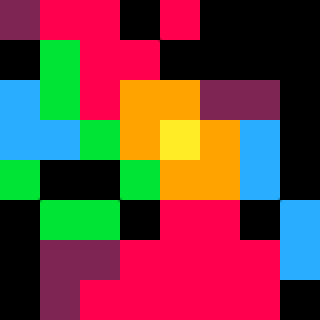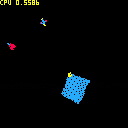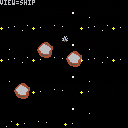I got to wondering whether you could rotate a sprite in PICO-8. Of course this facility is not provided, but it should be achievable, I thought.
How this works: 3 rotating objects. Arrows move the green cursor among them, and Z or X to toggle each object on or off.
The rotations are slightly ugly, but I think accurate. Smoothing could probably make them look better, but maybe not at reasonable cost. I don't know! Rotating the large sprite is CPU-intensive (and ugly!). I think for small objects this could be used in a game.
Issues:
- Sprites are rotated about their top left corner. I think this is needed to guarantee that atan2 is one-to-one. But it would be better to rotate around an arbitrary center!
- I forgot what the other issues are.









ADDED (7/31): Fixed some missing interactions; elastic collisions apply to the ship; re-did overlay; you can switch views; gravity calc is dropped at high distances.
Press 'Z' to switch views among ship and planetoids. Current view is displayed in overlay.
ADDED (7/31): Only detect collisions for nearby objects (fixes integer overflow issue).
ADDED (7/31): Elastic collisions (for planetoids), sound and music.
I've implemented perfectly elastic collisions between the planetoids. (I haven't done collisions for the ship, yet, partly because it's easier to detect collisions for circles.)
When two planetoids collide, a crashing sound plays and the planets exchange some energy and momentum (details). I'm pretty sure the math is accurate -- at least, the collisions look reasonably accurate. As with gravity, however, the math involved can involve large numbers and integer overflow could be a problem -- I don't know whether it actually does cause issues in the conditions I've built. (EDIT: I think it does. In particular, collision detection uses distance. But, because of integer overflow and sqrt, distances over ~181 roll back to 0. So very distant objects constantly collide with each other and go crazy. This makes the system less stable than it should be. A solution would be to only check collisions for nearby objects, using some cheap and safe heuristic (e.g. Manhattan distance).)










 12 comments
12 comments
